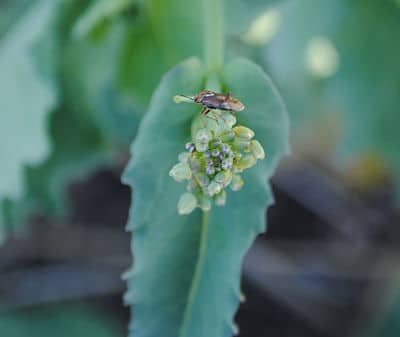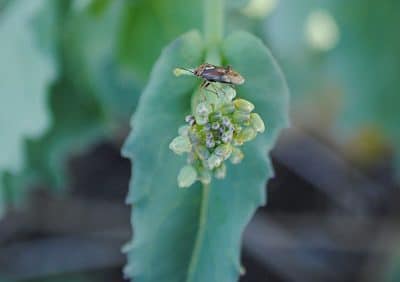 Lygus: Lygus bugs are feeding on canola in the Peace River region and in some parts of central Alberta. Insecticide control at the bud stage is rarely effective or economical. Under good growing conditions, canola can grow through this early damage without any yield loss. Instead of spraying, step up monitoring and proper sweep net sampling and be ready to take action at the pod stage if necessary. The tables below show thresholds for early and late podding. Click here for more on the current lygus situation.
Lygus: Lygus bugs are feeding on canola in the Peace River region and in some parts of central Alberta. Insecticide control at the bud stage is rarely effective or economical. Under good growing conditions, canola can grow through this early damage without any yield loss. Instead of spraying, step up monitoring and proper sweep net sampling and be ready to take action at the pod stage if necessary. The tables below show thresholds for early and late podding. Click here for more on the current lygus situation.
Cabbage seedpod weevil. Adults have arrived and are feeding on volunteer canola at the bloom stage in southern Alberta and southwest Saskatchewan. Weevils move to canola fields at the bud to early flower
stages. Growers should start scouting.
The proper way to sample for cabbage seedpod weevil adults is with a sweep net. Begin sampling when the crop first enters the bud stage and continue through the flowering period. Select 10 locations within each field and at each location, count the number of weevils from ten 180° sweeps. Sample both the perimeter and interior of the field to obtain an accurate estimate of weevil numbers throughout the field. Click here for more detailed information on proper sampling techniques.
The economic threshold for the weevil is 20 to 30 in 10 sweeps, depending on crop price.
It is important not to spray too soon, as the weevil will typically continue to invade for at least a week to 10 days after the first flowers open. The optimum time to spray for cabbage seedpod weevil is early flowering (10% flower if possible). Spraying at 10% flower will allow the weevils more time to move into the field, while at the same time it is still early enough to keep them from laying any significant number of eggs in the newly forming pods. Spraying after 10% flower when populations are at or above threshold may not only result in yield loss, but will also impact beneficial insects including pollinators who have moved into the field. It is important to keep in mind canola’s ability to compensate for weevil feeding on buds and stems where moisture is not limiting. Where moisture constraints are present, the ability to compensate may be reduced, and using the lower end of the threshold range may be appropriate. The Prairie Pest Monitoring Network provides identification and more monitoring tips: 2010_CSPW protocol
Scott Meers of Alberta Agriculture & Rural Development is recruiting scouts and crop consultants to enter cabbage seedpod weevil data into an online survey. This data will populate a google map that will show weevil hotspots in real time. Call 310-2777 and provide name, sample date, location (LLD or GPS), total number of sweeps, and total number of weevils in those sweeps.
Grasshoppers: Rain does not seem to be setting back the grasshopper threat in the Peace Region. Some growers are having to spray. The Prairie Pest Monitoring Network’s models predict the grasshopper hatch is more or less complete. Across the Prairies, 85% of the population is predicted to be in the first or second instar.
